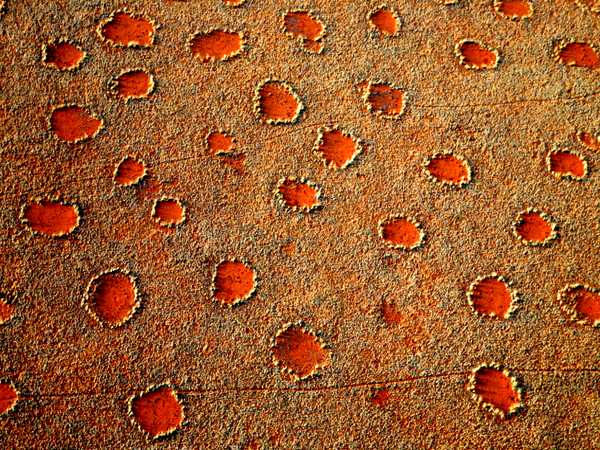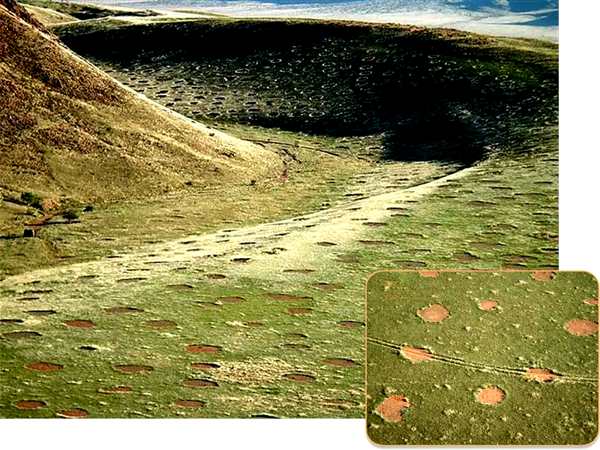Unraveling the Enigma of Namibia’s Fairy Circles
In the vast, sandy desert grasslands of Namibia, mysterious bare spots called “fairy circles” appear and vanish without any clear explanation. These peculiar formations have puzzled scientists, baffled locals, and captivated visitors for decades. Stretching across a wide swath of land from southern Angola to northern South Africa, fairy circles dot the landscape like a polka-dotted quilt. But what are they, and why do they form?
A Desert Phenomenon Unlike Any Other
Fairy circles are circular patches of bare, red soil that interrupt the otherwise dense green grass of Namibia’s desert. These circles range from 2 to 12 meters in diameter and are bordered by a ring of tall grass, making them stand out even more prominently against the sandy desert floor. Often found at altitudes between 500 and 1,000 meters, these circles cover vast areas, with thousands appearing between 60 to 120 kilometers inland from the coast.
Despite various theories, no one has yet pinpointed the exact cause of these formations. Some locals believe they are the “footprints of the gods,” while others see them as remnants of ancient fires or celestial impacts. The most prevalent theories, however, suggest natural causes like termite activity or specific mineral compositions in the soil. Yet, none of these explanations has been definitively proven.
A Lifelong Mystery and the Work of a Curious Scientist
Walter Tschinkel, a biologist from Florida State University, became fascinated with fairy circles during a 2005 safari in the Namib Desert. He began a personal quest to understand these enigmatic patterns. Through his research, Tschinkel discovered that the circles are not random; they are stable and have a lifespan. Small circles tend to last around 24 years, while larger ones can exist for up to 75 years.
Using satellite images from 2004 and 2008, Tschinkel found that fairy circles emerge almost fully formed or expand quickly once they begin. His findings, published in the journal PLoS ONE in June 2012, show that fairy circles are “alive” in a sense—they appear, change, and disappear over time.

Theories and Hypotheses: What Causes Fairy Circles?
Fairy circles’ remote locations—often 180 kilometers away from the nearest village—have made them difficult to study, and much of the research conducted has been opportunistic. Various theories have been proposed over the years:
- Termite Activity: One hypothesis suggests that termites eat the roots of the grass, creating the circular patches. However, no consistent evidence has shown that termites are present in every fairy circle.
- Toxic Gases or Mineral Compounds: Some speculate that toxic gases or mineral compounds in the soil may prevent plant growth within the circles. However, this does not explain the circular shape or why the circles are surrounded by a ring of taller grass.
- Self-Organization of Vegetation: A newer theory suggests that the circles result from self-organization, where vegetation competes for limited water resources, creating a natural pattern. This idea finds some support in computer models, but real-world evidence remains scarce.
A Unique Eco-Tourism Attraction
Despite the lack of a definitive explanation, fairy circles have become a popular attraction in Namibia. The NamibRand Nature Reserve, where these circles are abundant, has turned them into an eco-tourism feature, selling “adoptions” of fairy circles for about $50 each. While buyers don’t actually own the land, they receive the GPS coordinates and a certificate of adoption, allowing them to monitor their circles via Google Earth.
A Natural Wonder with No Clear Answers
Fairy circles remain one of Africa’s most intriguing natural wonders. Are they a product of environmental factors like soil conditions or water availability? Could they be biological, formed by termite activity or plant competition? Or are they something entirely different, perhaps a geological or extraterrestrial phenomenon?
While the exact cause of Namibia’s fairy circles remains a mystery, one thing is certain: they are neither a hoax nor a joke. Instead, they represent one of nature’s most curious puzzles, one that continues to draw scientists and tourists alike to the sandy grasslands of southern Africa.

